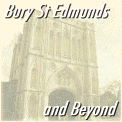 | |
To contact mi, click here This is an independent site |
 
HISTORY OF THE BUILDING THE NEIGHBOURING BUILDINGS
At the rear of the Norman core of Moyse's Hall is an L-shaped range of buildings now known as 41 Cornhill, part of which dates back to the early 16th century. There is some architectural and historical evidence to suggest that it was attached to Moyse's Hall from its earliest stages. Thomas Warren's map of 1741 shows that 41 Cornhill was then owned by the Guildhall Feoffment Trust and formed part of the Bridewell. However, the Guildhall Feoffees sold it in 1812, when they also sold the Castle Inn. For much of the 20th century it was used as shops. In 1972 the Council bought it and opened two new museum Galleries in the part immediately behind, Moyse's Hall. |
 The earliest surviving detailed map of Moyse's Hall, Thomas Warren's map
of 1741, shows that the Guildhall Feoffees also owned the property next to
Moyse's Hall (to the left of the entrance front) and that this was a public
house called the Castle Inn. Indeed, part of Moyse's Hall itself, the rooms
to the left of the modern entrance, was used by the inn. Warren calls it
'The Mansion House belonging to the Castle.' In 1812, the Guildhall
Feoffees sold the whole of the Castle Inn, including the Moyse's Hall
rooms. However, when Moyse's Hall was converted into a museum in
1899, this part was bought by the Borough Council from Greene King
Brewery and the Norman rooms were reunited as a single building. The
Castle Inn has now been gutted, but a beer cellar still survives under
Moyse's Hall as a reminder of its existence.
The earliest surviving detailed map of Moyse's Hall, Thomas Warren's map
of 1741, shows that the Guildhall Feoffees also owned the property next to
Moyse's Hall (to the left of the entrance front) and that this was a public
house called the Castle Inn. Indeed, part of Moyse's Hall itself, the rooms
to the left of the modern entrance, was used by the inn. Warren calls it
'The Mansion House belonging to the Castle.' In 1812, the Guildhall
Feoffees sold the whole of the Castle Inn, including the Moyse's Hall
rooms. However, when Moyse's Hall was converted into a museum in
1899, this part was bought by the Borough Council from Greene King
Brewery and the Norman rooms were reunited as a single building. The
Castle Inn has now been gutted, but a beer cellar still survives under
Moyse's Hall as a reminder of its existence.